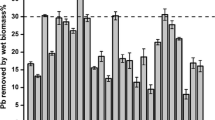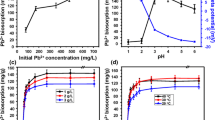Abstract
Through the study of biosorption of Pb2+ by lactic acid bacteria, two strains called CN-011 and CN-005 with high tolerance and great adsorption to lead were screened. The minimum bactericidal concentration of lead ions for both CN-011 and CN-005 was 1.45 mmol/L. The optimal culture conditions for the removal of 30 mg/L lead ions were achieved by culturing lactic acid bacteria at an initial pH of 7.0, 37 °C and 120 rpm for 48 h. The adsorption rate of CN-011 and CN-005 for Pb2+ were 85.95% and 86.78%, respectively. In simulated wastewater samples, the average adsorption rate of Pb2+ was 73.38% for CN-011 and 74.15% for CN-005. The mechanism of biosorption was characterized by Fourier Transform infrared spectroscopy, Scanning Electron Microscope—Energy Dispersive Spectrometer, X-ray Photoelectron Spectroscopy, which revealed that Pb2+ mainly reacted with hydroxyl ions in peptidoglycan or polysaccharide, and carboxylate radical in teichoic acid or protein on the surface of lactic acid bacteria cell wall. The deposits produced on the bacterial surface were identified as lead oxide and lead nitrate.









Similar content being viewed by others
Data availability
The data is available upon request to the corresponding author.
References
Ahemad M, Kibret M (2013) Recent trends in microbial biosorption of heavy metals: a review. Biochem Mol Biol 1(1):19–26. https://doi.org/10.12966/bmb.06.02.2013
Ayangbenro AS, Babalola OO (2017) A new strategy for heavy metal polluted environments: a review of microbial biosorbents. Int J Environ Res Public Health 14(1):94. https://doi.org/10.3390/ijerph14010094
Bogovič-Matijašić B, Rogelj I (1998) Bacteriocin complex of Lactobacillus acidophilus LF221—production studies in MRS media at different pH values and effect against lactobacillus helveticus ATCC 15009. Process Biochem 33(3):345–352. https://doi.org/10.1016/S0032-9592(97)00073-3
Bos R, Van der Mei HC, Busscher HJ (1999) Physico-chemistry of initial microbial adhesive interactions–its mechanisms and methods for study. FEMS Microbiol Rev 23(2):179–230. https://doi.org/10.1111/j.1574-6976.1999.tb00396.x
Chen Z, Leng X, Zhou F, Shen W, Zhang H, Yu Q, Qin M (2023) Screening and identification of probiotic lactobacilli from the infant gut microbiota to alleviate lead toxicity. Probiotics Antimicrob Proteins 15(4):821–831. https://doi.org/10.1007/s12602-021-09895-0
Dai QH, Bian XY, Li R, Jiang CB, Ge JM, Li BL, Ou J (2019) Biosorption of lead (II) from aqueous solution by lactic acid bacteria. Water Sci Technol 79(4):627–634. https://doi.org/10.2166/wst.2019.082
Doyle RJ, Matthews TH, Streips UN (1980) Chemical basis for selectivity of metal ions by the Bacillus subtilis cell wall. J Bacteriol 143(1):471–480. https://doi.org/10.1128/jb.143.1.471-480.1980
Gong Y, Wang Y, Lin N, Wang R, Wang M, Zhang X (2022) Iron-based materials for simultaneous removal of heavy metal (loid) s and emerging organic contaminants from the aquatic environment: recent advances and perspectives. Environ Pollut 299:118871. https://doi.org/10.1016/j.envpol.2022.118871
Groudev S, Georgiev P, Spasova I, Nicolova M (2014) Decreasing the contamination and toxicity of a heavily contaminated soil by in situ bioremediation. J Geochem Explor 144:374–379. https://doi.org/10.1016/j.gexplo.2014.01.017
Harrington RE, Guda T, Lambert B, Martin J (2020) Sterilization and disinfection of biomaterials for medical devices. Biomater Sci Acad Press. https://doi.org/10.1016/B978-0-12-816137-1.00091-X
Javanbakht V, Alavi SA, Zilouei H (2014) Mechanisms of heavy metal removal using microorganisms as biosorbent. Water Sci Technol 69(9):1775–1787. https://doi.org/10.2166/wst.2013.718
Khalil N, Morrow LA, Needleman H, Talbott EO, Wilson JW, Cauley JA (2009) Association of cumulative lead and neurocognitive function in an occupational cohort. Neuropsychology 23(1):10. https://doi.org/10.1037/a0013757
Lin D, Ji R, Wang D, Xiao M, Zhao J, Zou J, Li S (2019) The research progress in mechanism and influence of biosorption between lactic acid bacteria and Pb (II): A review. Crit Rev Food Sci Nutr 59(3):395–410. https://doi.org/10.1080/10408398.2017.1374241
Ma L, Zhang X, Ikram M, Ullah M, Wu H, Shi K (2020) Controllable synthesis of an intercalated ZIF-67/EG structure for the detection of ultratrace Cd2+, Cu2+, Hg2+ and Pb2+ ions. Chem Eng J 395:125216. https://doi.org/10.1016/j.cej.2020.125216
Mashkoor F, Shoeb M, Mashkoor R, Anwer AH, Zhu S, Jeong H, Jeong C (2023) Synergistic effects of tungstate trioxide hemihydrate decorated reduced graphene oxide for the adsorption of heavy metals and dyes and postliminary application in supercapacitor device. J Cleaner Prod 418:138067. https://doi.org/10.1016/j.jclepro.2023.138067
Mehenktaş C, Arar Ö (2023) Removal of zinc (Zn2+) through biopolymer-enhanced ultrafiltration. J Polym Environ 31(4):1373–1382. https://doi.org/10.1007/s10924-022-02686-w
Mortada WI, Kenawy IM, Abdelghany AM, Ismail AM, Donia AF, Nabieh KA (2015) Determination of Cu2+, Zn2+ and Pb2+ in biological and food samples by FAAS after preconcentration with hydroxyapatite nanorods originated from eggshell. Mater Sci Eng: C 52:288–296. https://doi.org/10.1016/j.msec.2015.03.061
Papadopoulos A, Assimomytis N, Varvaresou A (2022) Sample preparation of cosmetic products for the determination of heavy metals. Cosmetics 9(1):21. https://doi.org/10.3390/cosmetics9010021
Priya AK, Gnanasekaran L, Dutta K, Rajendran S, Balakrishnan D, Soto-Moscoso M (2022) Biosorption of heavy metals by microorganisms: evaluation of different underlying mechanisms. Chemosphere 307:135957. https://doi.org/10.1016/j.chemosphere.2022.135957
Rahman Z, Singh VP (2014) Cr (VI) reduction by enterobacter sp DU17 isolated from the tannery waste dump site and characterization of the bacterium and the Cr (VI) reductase. Int Biodeterior Biodegrad 91:97–103. https://doi.org/10.1016/j.ibiod.2014.03.015
Rola K (2020) Insight into the pattern of heavy-metal accumulation in lichen thalli. J Trace Elem Med Biol 61:126512. https://doi.org/10.1016/j.jtemb.2020.126512
Sadek AH, Asker MS, Abdelhamid SA (2021) Bacteriostatic impact of nanoscale zero-valent iron against pathogenic bacteria in the municipal wastewater. Biol 76:2785–2809. https://doi.org/10.1007/s11756-021-00814-w
Schwartz BS, Stewart WF, Bolla KI, Simon D, Bandeen-Roche K, Gordon B, Links JM, Todd AC (2000) Past adult lead exposure is associated with longitudinal decline in cognitive function. Neurology 55(8):1144–1150. https://doi.org/10.1212/WNL.55.8.1144
Svartengren M, ElindeC GR, Friberg L, Lind B (1986) Distribution and concentration of cadmium in human kidney. Environ Res 39(1):1–7. https://doi.org/10.1016/S0013-9351(86)80002-0
Tan SY, Praveena SM, Abidin EZ, Cheema MS (2018) Heavy metal quantification of classroom dust in school environment and its impacts on children health from Rawang (Malaysia). Environ Sci Pollut Res 25:34623–34635. https://doi.org/10.1007/s11356-018-3396-x
Topcu A, Bulat T (2010) Removal of cadmium and lead from aqueous solution by Enterococcus faecium strains. J Food Sci 75(1):T13–T17. https://doi.org/10.1111/j.1750-3841.2009.01429.x
Wang Y, Lu Z, Wu H, Lv F (2009) Study on the antibiotic activity of microcapsule curcumin against foodborne pathogens. Int J Food Microbiol 136(1):71–74. https://doi.org/10.1016/j.ijfoodmicro.2009.09.001
Wang X, Chen M, Xiao J, Hao L, Crowley DE, Zhang Z, Wu J (2015) Genome sequence analysis of the naphthenic acid degrading and metal resistant bacterium Cupriavidus gilardii CR3. PLoS ONE 10(8):e0132881. https://doi.org/10.1371/journal.pone.0132881
Wang WX, Douglas TR, Zhang H, Bhattacharya A, Rothenbroker M, Tang W, Chou LY (2023) Universal, label-free, single-molecule visualization of DNA origami nanodevices across biological samples using origamiFISH. Nat Nanotechnol. https://doi.org/10.1038/s41565-023-01449-5
Wulf S, Mizko L, Herrmann KH, Sánchez-Carbonell M, Urbach A, Lemke C, Wolf G (2023) Targeted disruption of the MORG1 gene in mice causes embryonic resorption in early phase of development. Biomol 13(7):1037. https://doi.org/10.3390/biom13071037
Xu M, Yang M, Xie D, Ni J, Meng J, Wang Q, Wu C (2021) Research trend analysis of composting based on Web of Science database. Environ Sci Pollut Res 28:59528–59541. https://doi.org/10.1007/s11356-021-16377-x
Zhang Y, Liu R, Yu R, Yang K, Guo L, Yan H (2022) Phosphorus-free hyperbranched polyborate flame retardant: Ultra-high strength and toughness, reduced fire hazards and unexpected transparency for epoxy resin. Compos B 242:110101. https://doi.org/10.1016/j.compositesb.2022.110101
Zoghi A, Khosravi-Darani K, SohrabvandS I (2014) Surface binding of toxins and heavy metals by probiotics. Mini-Rev Med Chem 14(1):84–98. https://doi.org/10.2174/1389557513666131211105554
Acknowledgements
This research did not receive any specific grant from funding agencies in the public, commercial, or not-for-profit sectors.
Funding
The authors have not disclosed any funding.
Author information
Authors and Affiliations
Contributions
GL: Conceptualization, Methodology, Data curation, Writing – original draft. WG: Methodology, Validation. YW: Methodology, Validation. YZ: Methodology, Validation. HC: Validation, Investigation, Writing – review and editing. ML: Validation, Investigation, Writing – review and editing. YC: Validation, Investigation, Writing – review editing.
Corresponding author
Ethics declarations
Conflict of interest
The authors declare that they have no known competing financial interests or personal relationships that could have appeared to influence the work reported in this paper.
Ethical approval
This article does not contain any studies with human participants or animals performed by any of the authors.
Additional information
Communicated by Yusuf Akhter.
Publisher's Note
Springer Nature remains neutral with regard to jurisdictional claims in published maps and institutional affiliations.
Supplementary Information
Below is the link to the electronic supplementary material.
Rights and permissions
Springer Nature or its licensor (e.g. a society or other partner) holds exclusive rights to this article under a publishing agreement with the author(s) or other rightsholder(s); author self-archiving of the accepted manuscript version of this article is solely governed by the terms of such publishing agreement and applicable law.
About this article
Cite this article
Liu, G., Geng, W., Wu, Y. et al. Biosorption of lead ion by lactic acid bacteria and the application in wastewater. Arch Microbiol 206, 18 (2024). https://doi.org/10.1007/s00203-023-03755-x
Received:
Revised:
Accepted:
Published:
DOI: https://doi.org/10.1007/s00203-023-03755-x




